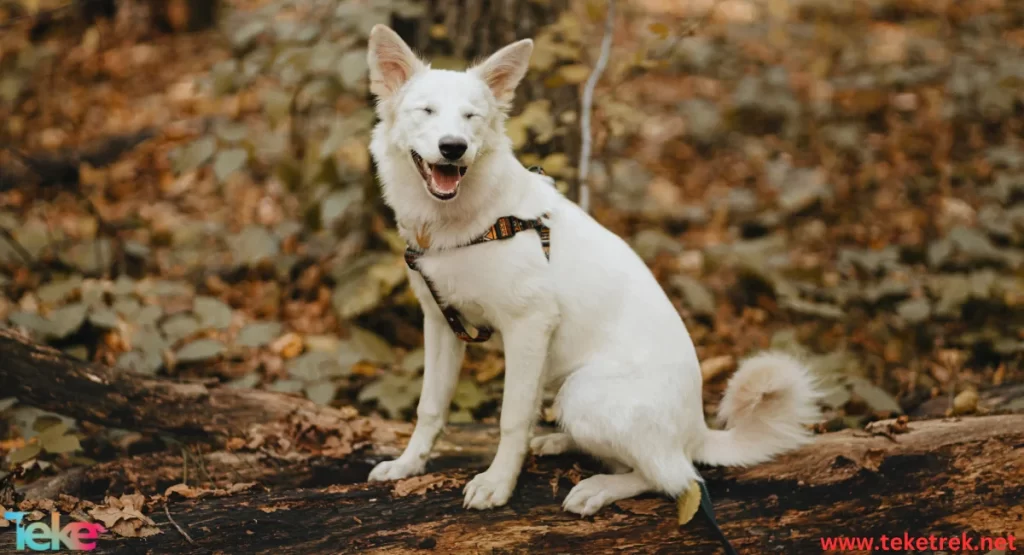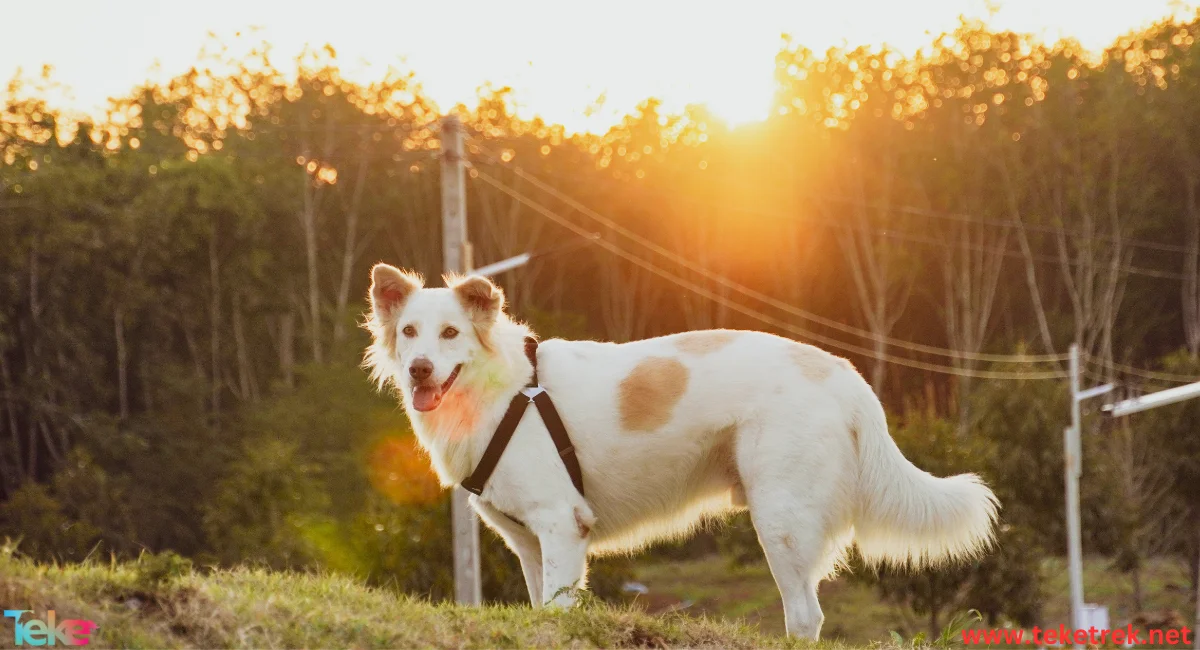Dogs are considered the perfect companions for humans during beautiful walks and social gatherings, as they are beloved by everyone. Below in Teketrek, we will discuss more about the dog, its lifestyle, and its behaviors.
Information about the dog
- All types of dogs vertebrate animals that have a backbone, share common characteristics regardless of their origins:
- They are mammals that give birth to live young, with females possessing mammary glands to nurse their offspring.
- Early breeds had erect ears and pointed or wedge-shaped muzzles, as seen in common northern breeds.

- Most carnivorous animals have similar dental structures, which paleontologists can identify. Dogs have 2 teeth sets: deciduous and permanent.
- Dogs walk on their toes, and they have fur on their bodies, which provides insulation. They also have an internal thermostat that allows them to maintain a constant body temperature despite external temperatures.
- Dogs come in a wide range of shapes and sizes; for example, Great Danes are huge, while Poodles are small. Both belong to the same species but are genetically identical and share the same anatomical features.
- All dogs have 78 chromosomes, with one member of each pair inherited from each parent. The normal body temperature for an adult dog is 100-102.5 degrees Fahrenheit.
Some amazing facts about dogs
- Dogs are known for their highly sensitive sense of smell and hearing. They possess millions of nerve cells in their noses, allowing them to detect scents remarkably well, including items buried underground.
- Dogs are renowned for their extreme loyalty to their owners. They may remain attached to their owners even in the most challenging circumstances.
- There are over 340 recognized breeds of dogs, each with its unique traits and characteristics.
- Dogs rank among the most intelligent pets, capable of mastering a wide range of skills and commands, and performing a variety of tasks with excellence.
- Dogs are not only loyal companions and devoted friends but can also contribute to improving their owners’ mental health. Research shows that interacting with dogs reduces stress and anxiety levels and enhances feelings of happiness.
- Dogs have a remarkable ability to notice subtle changes in their surroundings, and they are considered some of the most emotionally sensitive pets to their owners’ feelings.
- People utilize dogs in various fields including search and rescue, guarding, detection, providing emotional support, and alerting to health crises such as heart attacks before they occur.
Dog food
- The daily diet of an adult dog should consist of 50% carbohydrates depending on weight, including 2.5-4.5% fiber.
- At least 5.5% of the diet should come from fats and 10% protein. Pet food labels typically do not list quantities of essential nutrients in grams.
Reproduction in dogs
- Dogs are mammals animals that reproduce by giving birth, but they will not reach reproductive maturity during the first year of life. Most dogs reach sexual maturity at around six months old, although smaller breeds may start earlier, even as early as four months, while larger breeds may take up to two years to reach reproductive maturity.
- In females, the first heat cycle typically begins around six months of age. Male dogs do not go through a fertility cycle but respond to pheromones released by nearby females in heat. A male puppy may start showing hormone-driven behaviors as early as four months old.
Dog mating stages
Female dogs go through two heat cycles, or “estrus,” annually, which may be more spaced out in smaller dogs or more frequent in larger breeds. Each heat cycle lasts for about two to three weeks and is divided into the following four stages:
1. Proestrus: The first 7-10 days of the heat cycle when male dogs are attracted to the female, but mating is not allowed.
2. Estrus: The mating period, lasting from 5 to 10 days, during which bleeding stops.
3. Diestrus: This period lasts from 10 to 140 days, depending on whether the female is pregnant or not.
4. Anestrus: Anestrus: The period of rest between two heat cycles.


Types of dogs
Some of the prominent dog breeds include:
1. Pit Bull:
- The Pit Bull, also known as Canis lupus familiaris, is a domestic mammal belonging to the Canidae family within the order Carnivora. It is a sub-species of the gray wolf (Canis lupus) and is closely related to foxes and jackals. Dogs have been one of the most widespread and popular pets in the world for over 12,000 years, living alongside humans as hunting companions, protectors, and friends.
2. Chihuahua:
- Chihuahuas can have either long or smooth coats, and research has shown that dogs are faster and stronger, and dog can see and hear better than people. People selectively bred breeds that demonstrate these traits to enhance them. Strong dogs like Dobermans were specifically developed to protect homes and travelers from harm.
- As society changed, farming and hunting became essential for sustaining life, leading to the development of other breeds of dogs. Farmers considered dog breeding and guardianship crucial for protecting their herds or providing playmates and companionship for noble families.
- People bred the Pekinese, one of the sons of Beijing in China, and delicate breeds like Chihuahuas to be small dogs. They selected and bred terrier breeds, primarily developed in England, for specific tasks related to helping hunters find and capture prey.
Shiba Inu:
- The Shiba Inu is a Japanese dog breed that is considered one of the oldest dog breeds in the world. The Shiba Inu is a small to medium-sized dog known for its strong and independent personality. It is characterized by its beautiful appearance, pointed ears, and curled tail.
The origin of the dog and the stages of its development
- Paleontologists and archaeologists have determined that small mammals resembling today’s dogs lived around 60 million years ago. One such mammal, called Miacis, inhabited parts of Asia and is considered the ancestor of various modern species, including dogs, foxes, wolves, and jackals.
- Around 30 to 40 million years ago, Miacis evolved into the first true dog known as Cynodictis. Cynodictis was a medium-sized animal with a long body, a long tail, and a somewhat soft coat.
- Later, two branches emerged—one in Africa and the other in Eurasia. The Eurasian branch, or Tomarctus as it is known, is the ancestor of wolves, dogs, and foxes.
- The evolution of dogs from the gray wolf resulted in over 400 distinct breeds. Humans played a significant role in creating dogs that catered to specific societal needs.
- While the details of dog evolution are not entirely confirmed, early dogs were likely hunters with strong senses of sight and smell. Humans then developed these instincts further and created new breeds as needed.
- Fossil remains indicate the existence of five different types of dogs in the early Bronze Age, around 4500 BCE. These included guard dogs, wolf-like dogs, hunting dogs like Salukis and sighthounds, as well as herding dogs.
The status of dogs through the ages
Dogs are viewed differently in various parts of the world:
In Western societies, dogs have earned a significant status due to their traits of loyalty, friendship, protection, and affection. In the United States and Europe, caring for and feeding dogs has become a multi-billion-dollar industry.
Western civilization has placed great importance on the relationship between humans and dogs. However, in some developing countries and several regions of Asia, dogs do not receive the same level of appreciation.
In some parts of the world, dogs are used as guards, working animals, or even as food, while in the United States and Europe, dogs are admired and protected.
Egypt during the time of the pharaohs, dogs were considered sacred.
The Dog as an Ideal Companion in Daily Life
For thousands of years, dogs have accompanied humans on their life journey, and this relationship has evolved into one of the deepest bonds between people and animals. The dog has never been just a pet; it has become a true partner in many aspects of daily life. At a time when psychological and social pressures are on the rise, the dog offers immense emotional and psychological support and significantly enhances overall quality of life. In this article, we shed light on the importance of the dog as an ideal companion and how it can be an essential part of social and family life, in addition to its positive impact on mental health, as well as tips for care and training.
The Dog as an Ideal Daily Companion
A dog is an ideal daily companion thanks to its loyalty and devotion, in addition to its energy and liveliness that make it a perfect partner for daily activities like walking and running. Many people find motivation to exercise and improve their lifestyle through morning or evening walks with their dogs. These activities are not only physical but emotional as well, as people feel happy and reassured while spending time with their dogs.
Dogs in Social Gatherings
Dogs play a prominent role in strengthening social bonds among individuals. In public parks, for example, people often strike up conversations because of their dogs, creating opportunities to build new friendships. Dogs also participate in community events such as “Dog Day” or dog races, helping to foster a more connected society where people share interests and enjoy time together.
Dogs and Outdoor Activities
One of the most enjoyable experiences with your dog is engaging in outdoor activities. Whether you enjoy hiking through forests, running in the park, or even camping, your dog makes an excellent companion. Dogs love exploring new places, and their excitement makes adventures more enjoyable. Trips to the beach or mountain areas are also ideal, as dogs love running and playing in nature.
Dogs in Family Life
A dog can become an inseparable part of the family, adding a spirit of love and warmth to the home. When children are involved in feeding or caring for the dog, they learn responsibility and compassion. A dog shares the family’s daily moments and becomes a friend in both joy and sorrow, strengthening familial bonds.
Mental Health and Dogs
Many studies have shown that having a dog improves mental health. Dogs help reduce stress and anxiety levels, offering their owners a sense of comfort and safety. Simply playing with a dog or having it nearby can alleviate feelings of loneliness. This is why dogs are often used in therapy and emotional support, especially for people with anxiety and depression. In this role, the dog proves to be a loyal friend to humans.
How to Care for Your Dog in the Summer
With rising temperatures in the summer, dog owners must take precautions to protect them from heat. Key tips include ensuring clean, fresh water is always available, avoiding outdoor walks during peak sun hours, and providing shaded resting spots. Hot surfaces like asphalt can harm a dog’s paws, so it’s important to be cautious and use protective creams if necessary.
Interaction Between Dogs and Children
Dogs are highly effective in developing children’s social and emotional skills. Through interacting with dogs, children learn values like compassion, respect, discipline, and responsibility. A dog in the home provides children with a sense of security and encourages emotional expression and better social interactions. Thus, dogs are ideal and safe companions for children.
Training Dogs for Walks
To enjoy walks with your dog, proper training from a young age is crucial. Using the right collar and leash, and teaching basic commands like “stop” and “come” are essential. Positive reinforcement through treats helps encourage good behavior. Regular training ensures that walks are enjoyable and safe for both dog and owner.
Types of Social Activities Dogs Enjoy
Dogs love participating in various social activities like visiting dog parks, joining group training classes, or competing in obedience or agility contests. These activities allow dogs to interact with others while strengthening the bond with their owner through play and challenge.
How to Choose the Right Dog for Your Social Lifestyle
Choosing the right dog depends on understanding your lifestyle and social needs. Active individuals who love adventure may prefer energetic breeds like Labradors or Huskies. Those who enjoy calm, indoor living might be better suited to small breeds like Chihuahuas or French Bulldogs. It’s also important to consider your living space, whether you have children, and how much time you can dedicate to caring for a dog. The right dog for one person may not suit another, depending on personal preferences and habits.
The Importance of Play in a Dog’s Life
Play and fun are essential to a dog’s life. They’re not just forms of entertainment but are crucial for physical and mental development. Through play, dogs develop social skills and learn how to interact with their environment and other beings. Play helps release excess energy, reducing negative behaviors like excessive barking or furniture destruction. It also stimulates the dog’s mind and prevents boredom or depression, especially in indoor environments. Interactive games such as fetch or puzzle toys improve focus and build confidence. Playtime also strengthens the relationship between dog and owner and contributes to physical health by keeping the dog fit and at an ideal weight. Therefore, play should never be underestimated—it’s the key to a healthy, happy, and balanced dog.
Dogs in Urban Life
In big cities, dogs face challenges such as noise, limited space, and a lack of open areas. However, with the right adjustments, dogs can live happily even in small apartments. Daily walks, indoor toys, and early socialization are crucial to prevent boredom and stress. Dogs are social animals, and this aspect of their life must be considered, especially in urban settings.
FAQ
What is a dog?
It is a vertebrate mammal of the Canidae family.
Where do dogs live in the world?
Dogs live on various continents of the world, with the exception of Antarctica, and they adapt to various temperate, hot, and rainy environments.
What is the language of dogs?
Dogs communicate with each other through body language and facial expressions. When they are afraid or upset, their hair stands on the back, while it bares its fangs when it is sharp and extremely hostile. The dog grimaces, lowers its ears, lowers its tail, and raises its hair and tail and barks.
In conclusion, dogs are mammals that reproduce by giving birth and are known for their versatility in various roles. They are not only companions but also serve humans in different capacities.







Your point of view caught my eye and was very interesting. Thanks. I have a question for you.
Thank you
Thank you for your sharing. I am worried that I lack creative ideas. It is your article that makes me full of hope. Thank you. But, I have a question, can you help me?
Thank you